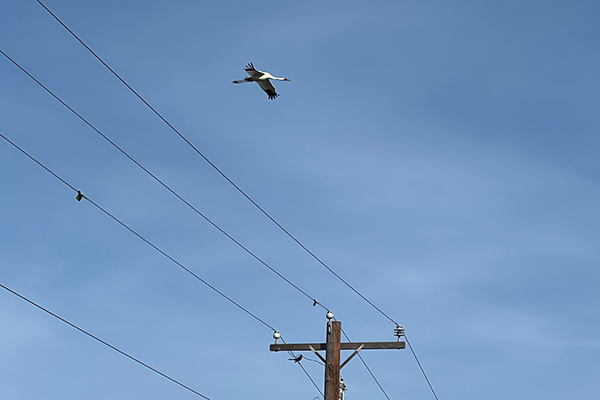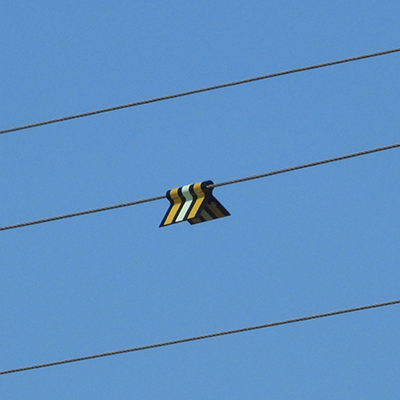
International Crane Foundation and AEP Texas Partner to Save Cranes
CONTACT: Jodi Legge, Director of External Affairs, 608-356-9462, ext. 120; Carter Crouch, Ph.D. Director of Gulf Coast Programs, 940-704-6008
Feb. 13, 2024 (Rockport, TX) – A year since an Endangered Whooping Crane was killed after colliding with a powerline near the Big Tree in Lamar, Tx., this area is now safer for these iconic birds. In the months following the collision, the International Crane Foundation worked in partnership with staff at AEP Texas and the local community to help develop a solution to decrease the possibility of this type of incident happening again.
Powerline collisions are a global issue, and large birds, like cranes, are particularly vulnerable. While burying powerlines can prevent collisions, this solution is very expensive and many times not feasible due to various competing constraints.

One alternative and cost-saving solution is the use of bird flight diverter technology. This technology has shown promise in decreasing strike frequency. The evolution of diverter technology has improved its efficacy, and diverters have varying rates of success based on how they are deployed. The Foundation advocates for the most effective diverters, including those that glow in the dark and have a reflective component to ensure birds see them at night.
Since the Whooping Crane death last year, the Foundation provided diverter recommendations to AEP Texas to prevent this from happening again. AEP Texas was open to suggestions and quick to work toward a solution. As a result, in the fall of 2023, prior to the crane’s return, AEP Texas installed diverter technology on powerlines where the incident occurred. “We truly appreciate the partnership and quick response of AEP Texas,” said Dr. Carter Crouch, director of Gulf Coast Programs at the International Crane Foundation. “This is a high-use area for Whooping Cranes and an incredibly important area to the community, and I am happy to see this site safer for them this year.
“We truly appreciate the partnership and quick response of AEP Texas. This is a high-use area for Whooping Cranes and an incredibly important area to the community, and I am happy to see this site safer for them this year.
Dr. Carter Crouch, Gulf Coast Programs Director
AEP Texas Vice President of Distribution Region Operations Jeff Stracener emphasized, “This specific situation involving an endangered species presented a unique opportunity to use diverters with very minimal changes to our distribution system.”
Cranes and other species continue to navigate a human-dominated landscape, often dying as a direct result of climate change and human population growth.
The International Crane Foundation is committed to collaborating with neighbors, communities, partners, and companies to assist in planning for growth in areas where endangered cranes live.
The International Crane Foundation works worldwide to conserve cranes and the ecosystems, watersheds, and flyways on which they depend. We provide knowledge, leadership, and inspiration to engage people in resolving threats to cranes and their diverse landscapes. From its 300-acre headquarters in Baraboo, Wisconsin, the Foundation’s reach extends across the globe, with offices and staff in China, Uganda, Kenya, Zambia, and South Africa, as well as Texas. It works through strong partnerships with local organizations, governments, universities, businesses, and others in these regions. More than 125 Foundation staff and partners work with a network of hundreds of specialists in 50 countries on five continents. The Foundation is committed to a future where all 15 of the world’s crane species are secure. Through the charisma of cranes, the International Crane Foundation envisions a future where people work together for wild crane populations and the landscapes they depend on – and by doing so, find new pathways to sustain our water, land, and livelihoods. Visit savingcranes.org for more information and to support our work.
In Texas, our staff conducts research on Whooping Cranes and their habitats, works with landowners and partners to protect and provide habitat and address threats, and leads outreach and community engagement to increase awareness and empathy for Whooping Cranes.
